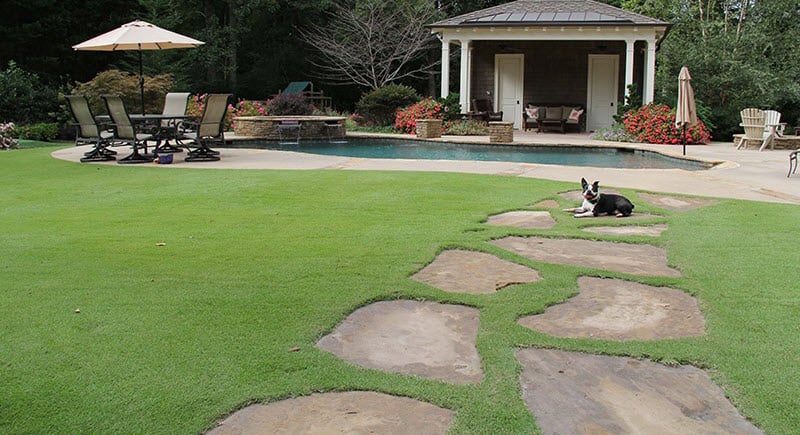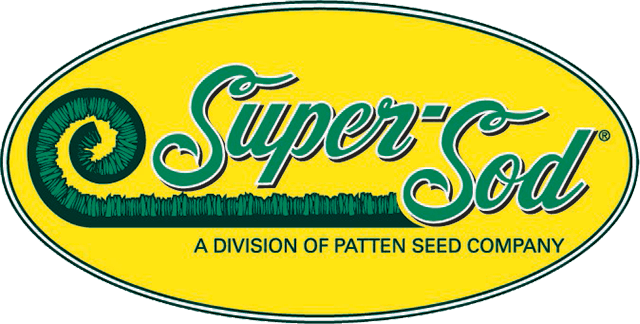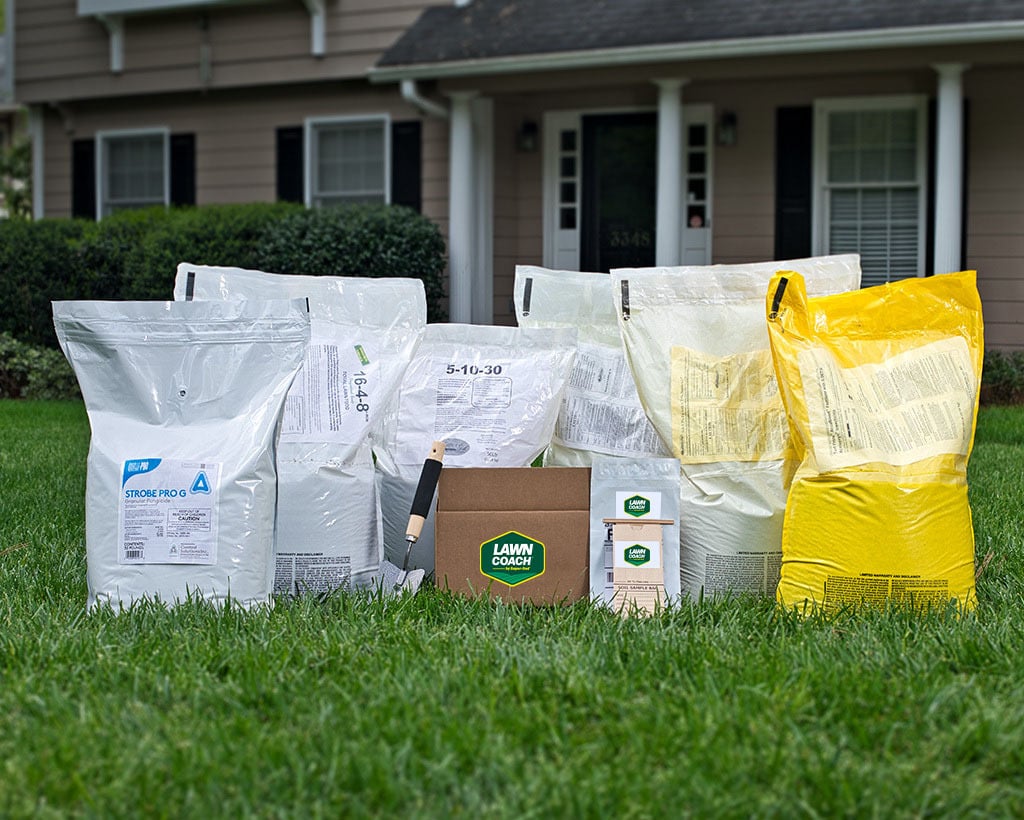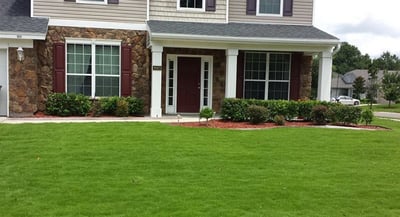

You planned the installation and watered your sod religiously until it was established. Now, follow these simple steps to achieve the lush Zeon lawn you’ve dreamed of:
Bookmark this Zeon Zoysia lawn care page, then subscribe to our Monthly Lawn Tips so we can email you lawn care tips and alerts.
Mowing a Zeon Zoysia Lawn
- Mow at 1.5 inches cutting height.
- Mow no more than 1/3 of the leaf off at one mowing. Use sharp mower blades and catch and remove clippings. Can be mowed with rotary or reel mower.
- Less frequent mowing requirements (second only to Centipede) - mowing may be required on a 7-to-10-day interval.
| Mow when grass is this tall: | 1.5 to 2 inches (5cm) |
| Set cutting height of mower to: | 1 to 1.5 inches (3.7cm) |
Watering Zeon Zoysia Sod
Water to supplement rainfall shortages only. Avoid fixed timer irrigation settings.
Though drought tolerant, Zoysia best performs when it receives approximately 1" of water per week. If one or more inches of rainfall occur in a week, additional irrigation is not necessary. (Example: if 1/2" of rain occurs within a growing week, apply 1/2" by irrigation.)
Do not waste water by over watering; avoid run-off and standing water for any period of time. To learn more here's insight on How and When to Water Your Lawn.
Become a master at watering your lawn when you read all our Watering Guides.
Fertilizing Zeon Zoysia
- Apply between 2 and 3 pounds of nitrogen per 1,000 square feet annually, during the growing season. Select a fertilizer that is labeled for use on Zoysia grass lawns. Do not apply fertilizer to wet turf to avoid burning. Too much fertility will result in a thatchy, unhealthy lawn and increased disease risk.
- Once Zeon turf is matured, apply moderate nitrogen according to the table below. It can maintain good density and color and need cutting only every 10 days at low fertility levels. Higher fertilizer levels produce deeper color, but more growth means more frequent mowing and increased risk of diseases.
- Fertilize according to the table below and according to soil test recommendations.
- Special note: don’t fertilize your Zeon Zoysia lawn with high Nitrogen fertilizer in fall or winter.
- Read about How to Calculate Fertilizer Rates.
- Supplemental application of iron will improve grass color, but most Super-Sod fertilizers already contain iron.
- Lime can safely be applied any time of year. Lime based on feedback from soil test recommendations.
Weed Control for Zeon Zoysia Sod
- Zeon Zoysia's dense growth can retard weed infestation, however the best weed control is preventive:
- Regular mowing
- Pre-emergent herbicide, recommended for use on Zoysia lawns on the label, is strongly recommended in the spring and fall
- Apply pre-emergent and post-emergent weed control products that are specifically labeled for Zoysia lawns. Do not apply pre-emergents 4 months prior to laying new sod.
- Apply pre-emergent weed control according to the table below. Read and follow herbicide label directions.
- Apply post-emergent weed control to weeds you can see, as needed.
- Special note: While Zoysia is a very dense grass that crowds out some weeds, the reality is that Zoysia lawns require herbicides to prevent weed infestations.
- For assistance with weed identification and pest control contact your nursery/garden center, landscaper, or local Cooperative Extension Service agent, or browse our Weed of the Month section.
Look up Super-Sod's yellow spreader settings here.
Month |
Fertilizer & Weed Control (lbs/1000 sq.ft.) |
Timing |
| FEB | 0-0-7* + Iron w/ pre-emergent @ 6 lbs. | first week |
| APRIL | 16-4-8 + Iron w/ pre-emergent @ 6 lbs. | after last frost |
| JUNE | 16-4-8 + Iron @ 6 lbs. | middle of month |
| JULY | 5-10-30 + Iron w/ Acelepryn (insecticide) @ 5 lbs. | middle of month |
| AUG | 5-10-30 + Iron @ 5 lbs. | middle of month |
| SEPT | 0-0-7* + Iron w/ pre-emergent @ 6 lbs. | middle of month |
*Low nitrogen
Additional Zeon Zoysia Maintenance
- Pests can become a problem, especially if Zoysia is not growing healthily (too much fertility or water, etc.).
- Fungus Control: Zoysia Patch disease (Rhizoctonia fungus) can be a problem on over-fertilized lawns. Due to our cold, wet winters, we recommend applying fungicide to Zoysia lawns according to this schedule.

Month |
Fungicide |
Timing |
| APRIL | Professional fungicide | middle of month |
| OCT | Professional fungicide | middle of month |
- Some rust may be expected in cool spring weather and other leaf diseases may show up in hot, humid weather, but the grass will usually recover if water and fertility levels are minimized.
- Soil insects such as grubs and mole crickets are minimal problems.
- Thatch Removal: Periodically it may be necessary to remove accumulated thatch. This is best accomplished just before turf turns green (which is approximately late winter in the coastal plain and spring further north). Scalp with a lawn mower or de-thatch with a commercial machine and remove debris.







